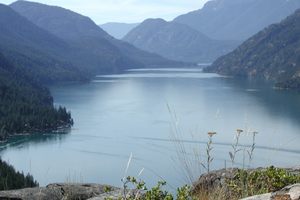
Lake Chelan invites superlatives. It is extraordinarily narrow: it extends over 50 miles into the heart of the Cascade Range, but averages only a bit more than a mile wide. It is the deepest lake in Washington (and the third-deepest in the United States) at 1,486 feet, behind only Crater Lake in Oregon (1,949 feet) and Lake Tahoe between California and Nevada (1,645 feet). It sits in a glacially carved valley, oversteepened by the glaciation, such that not only are the slopes extremely steep but the lake floor itself was gouged out by the weight of the ice to below sea level, to a maximum of 436 feet. The resulting gorge has been claimed to be the deepest in North America, if measured from the bottom of the lake.
As expected, one result is breathtaking mountain scenery, much of which is now preserved. Even though wildfires in recent years have damaged much of the forest cover, lots of spectacular country remains.
Because the rugged terrain is not conducive to road building, vessels plying Lake Chelan (pronounced "sheh-LAN") formed a major part of the local transportation infrastructure until well into the 20th century, and remain important even to this day. Up canyon from the village of Stehekin (pronounced "steh-HEE-kin"), at the northwest end of the lake, a road formerly ran to mines and prospects. However, its maintenance was so expensive, and the cost of transshipping ore to a barge at Stehekin and then back to a truck or railroad at the other end of the lake was so high, that the mines were uneconomic. The road above Stehekin now provides access to North Cascades National Park and only extends about 15 miles. Stehekin itself still has no road access—vehicles are brought in by barge—but aside from local demand, the traffic is all tourism-related now.
In contrast to the wilderness surrounding the northwestern tip of the lake, the southeast end has more subdued topography and is considerably more developed. Besides the towns of Chelan and Manson, and their surrounding exurbs including lakefront property, there is extensive agriculture, including abundant apple orchards and vineyards. This end of the lake is also warmer both because it is shallower, and because it gets more sun exposure due to the lower surrounding hills. In the summer, it is a focus of more "conventional" lake recreation. It even includes some beaches.
0 comments:
Post a Comment